Downtown Davenport Master Plan Progresses, With City Council Blessing
After being bruised and battered from the spring 2019 flood and the 2020 pandemic, downtown Davenport is looking to a much brighter 2021, as the Davenport City Council officially accepted a comprehensive downtown master plan at its Jan. 27 meeting.

A view of downtown Davenport at night.
That marks a milestone for the project started a year ago by the Downtown Davenport Partnership (DDP), an affiliate of the Quad Cities Chamber.
“As downtown goes, so goes Davenport and the Quad-Cities,” said DDP executive director Kyle Carter. “Our community is well-prepared to rebound quickly from a challenging couple of years with this roadmap for the future.”
Last February, the partnership hired a nationally recognized, award-winning planning and urban design team – New York City-based WXY Studio – to develop a new downtown master plan. DDP paid the $130,000 for the plan’s creation; no general taxpayer dollars were spent to cover consultant fees.
WXY says it’s dedicated to “engaging, improving, and honoring public space,” according to wxystudio.com. “We design in conversation with the environment. We work to understand a context, and plan with community in mind.”
WXY Studio, along with SB Friedman Development Advisors and Sam Schwartz Engineering, worked with DDP to develop a downtown strategy for future growth. Part of the planning process included stakeholder interviews, focus group meetings, a public perception survey and feedback from a steering committee of business owners, residents and developers.
Guided by a 15-person steering committee, the team engaged representatives from more than 75 organizations in stakeholder interviews and

The skybridge, which crosses River Drive, in Davenport.
focus groups, and collected over 550 responses in an online perception survey
The consultants incorporated a lot of input from Quad Citizens, city policymakers, developers, community advocates and business leaders into the plan — despite not being able to hold in-person meetings due to Covid-19.
Carter was impressed by how many virtual meetings they were able to do, and their robust attendance.
“We were constantly holding these stakeholder meetings via Zoom, and it was a lot of work to make sure we got that public input and the stakeholder feedback,” he said Tuesday. “We got it and I think it’s shown in the quality of the final product. It clearly, in its scope and in its breadth of what it tries to tackle, is very inclusive.”
At Wednesday night’s city council meeting, Carter laid out the importance of the 120-page master plan – which does not obligate city funding

Kyle Carter is executive director of the Downtown Davenport Partnership.
for implementation now.
“It’s an opportunity to provide Davenport and the Quad-Cities a new vision of hope in a world after Covid,” he said. “An opportunity to say with confidence that we will meet the challenge to balance both downtown’s flood protection needs and our century-long commitment to making the riverfront a vibrant, world-class destination.
“An opportunity to use our most precious downtown resource, our public streets, gathering spaces, and sidewalks…to prioritize people, walkability, safety, and small business growth – not speeding traffic in a hurry to be somewhere else,” Carter said. The plan also offers:
- Opportunity to build a more equitable business ecosystem that lifts up local entrepreneurs, provides competitive advantages to attract workforce for large offices, and still looks out for the little guy.
- Opportunity to build nationally competitive, diverse, new/historic housing options for people of every income level and background.
- Opportunity to further leverage our historic districts and our backbone of the arts, hospitality, and entertainment industries that led the prior 20 years of growth…and will likely lead the next.
- Opportunity to strategically and intentionally plan our open spaces, public assets, and private properties to create new developments that build our city’s tax base and cultural well-being.
- Opportunity to reach out to people who may not have felt welcome in the past, to begin calling downtown their own, and to build a place they see themselves and their children enjoying.
“And finally, we have an opportunity to lead,” Carter said. “To show through action and vision, we believe Davenport’s best days still lay ahead of it.”
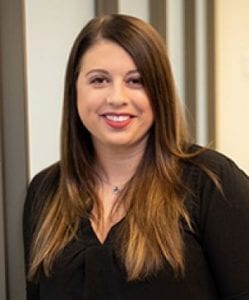
Alisha Espy is program director for the Downtown Davenport Partnership.
“I’d like to thank the WXY team, our steering committee, DDP/Chamber Board and staff, city staff, City Council, and the more than 75 organizations represented by our stakeholder interviews and the 550 members of the public who responded to our surveys during the pandemic, when public meetings were nearly impossible,” he told the council.
“But most of all, I’d like to thank my colleague, Alisha Espey, without whom a downtown master plan of this caliber would not have been possible,” he said of DDP’s program director. “It was her unflinching attention to detail that will ensure Davenport can be proud of it for years to come.
“Even following a global pandemic, she remained laser focused on facilitating and leading what I believe to be one of the best downtown master plans of any city, of any size in the United States today,” Carter said.
“No plan can guarantee what will get accomplished, but I can guarantee, DDP will work tirelessly to ensure the private and public sectors work in concert to get as much of this plan done as humanly possible,” he said. “We are a resilient city. As result of this plan, may we indeed produce something greater socially, culturally and economically, than the sum of our separated parts.”
“The public sector working with the private sector to get any of this stuff done is crucial,” Carter said Thursday.
There’s no overall price tag for the plan, since each specific project will have to be vetted and approved by the city council.
“This is a plan, not a promise,” Carter said. “This is what we want to do, but each project will be individually vetted by council as it comes to be. There’s no point in putting a price tag on something that may or may not happen. We have got to decide what our priorities are out of

The vacant 1920 Capitol Theatre on West 3rd Street is brightly restored in the master plan vision.
this, what we can do, and then you bid it and go through the whole public process like any major project that’s been recommended that has a public aspect.”
What is in the plan?
The underlying framework of the plan – “Davenport 2030: A Resilient City” – is a guide for the activation and development of the downtown, rather than a rigid vision of what the downtown will become. The plan’s mission statement is:
By 2030, Davenport has the potential to be a thriving residential center, a space for entrepreneurship and innovation, and a hub for entertainment, arts, and play.
To achieve that goal, Davenport must invest heavily in its streets, public spaces and riverfront, connect small businesses and entrepreneurs to capital, and focus on creating a unique and inclusive downtown experience.

The downtown Davenport master plan was commissioned in February 2020.
The plan’s five pillars for growth are to be playful, connected & protected; livable; innovative; inclusive; and celebrated.
- Playful, Connected & Protected — Enhance the downtown public realm and create a more resilient riverfront.
- Livable — Make downtown an attractive place for residents, families, and visitors.
- Innovative — Create an entrepreneurial ecosystem focused on attracting jobs, talent, inclusivity, and innovation
- Inclusive — Create a diverse, equitable, and inclusive downtown through the design and programming of the public realm, fostering a small business entrepreneurial ecosystem, and creating varied housing options
- Celebrated — Define Downtown Davenport’s identity and brand within the region as an unconventional, inclusive, and unforgettable destination.
Here are some of the projects DDP already has in the works since completing the plan:
- Develop principles for the riverfront that balance flood protection with world-class design and work to embed these principles in the city’s ongoing flood resiliency engineering study.
- Build public realm infrastructure that prioritizes walkability, safety and business growth with the return of two-way streets and expanded streetscape.
- Create a DDP public art committee and mural program with the goal of completing the first project this spring.
- Implement a new block-party event model in addition to traditional summer festivals; programming could include outdoor dining, films, music and other activities.
- Hire two downtown ambassadors this spring to provide public hospitality services for downtown visitors, businesses and residents, including daily engagement with housing social-service partners, on-street presence to help deter crime and assistance with sidewalk cleaning.
- Establish an equitable entrepreneurial ecosystem with regional partners to offer financial tools, mentoring, coaching and other assistance
- Seek connections with groups and individuals interested in producing multicultural events to increase support of diverse programming

The Downtown Partnership (an affiliate of the Q-C Chamber) paid the $130,000 for the master plan, with no public dollars used.
One of the things the pandemic revealed is the city can and should do smaller events, Carter said, noting those will be clustered within one or two blocks. “Bars, restaurants and retailers will be able to absorb most of the money made at those events,” he said. “We’re more of a conduit to help them do that.”
“We’ll have fewer large-scale events, and have more smaller ones, that happen more often,” he said. “Another example of that would be utilizing a space like Kaiserlautern Square, or the Figge plaza, for instance – to host more events in general. And they aren’t necessarily produced by us.”
The renovation of Kaiserslautern Square Park — next to Duck City Bistro, and across 3rd Street from the Adler Theatre – is expected to be finished this summer.
“We want to have a real intentional outreach to some of our other cultural organizations in the region,” Carter said. “I encourage them to use these spaces and make them their own. We don’t have to produce everything, but we need to do some outreach to make sure other people feel welcome to do so.”
Icestravaganza (organized by DDP) in mid-January is an example of an annual event that changed this time, but still happened safely with Covid going on, he said, “We can’t predict the future of what Covid will look like over the next year, but we’ll be prepared as best we can,”

Kyle Carter is executive director of the Downtown Davenport Partnership.
Carter said.
There have been grants received for the pilot ambassador program, and they want to find permanent funding, Carter said.
“Especially larger cities, where you see ambassador programs, you have somebody with a radio on, probably has a uniform,” Carter said. “They’re giving directions, being present on the streets when we have any kind of safety issues, an extra pair of eyes on the street when we need to get in contact with police. But mostly, their role is one of hospitality – being a friendly face and a presence to help people get around and find what they’re looking for.”
Ambassadors also will work with Humility Homes to address homelessness and get people into housing, he noted. “Our guys will intentionally stay in close touch with them. The ambassadors also will take formal training that Visit Quad Cities is about to offer – on a certification program that we’re really excited about, too.”
“We’re just getting started, but I’m particularly excited about our capacity to leverage new construction on several large sites downtown,” Carter said. “We’ve thought a lot about how we can grow our downtown in a way that benefits both those who have already invested their lives here and those who decide to invest here in the future.”
“We’re really excited about getting our welcoming and inclusive group off the ground too,” he added. “We’re going to be convening that yet this year. We’re excited there is progress on Martin Luther King Park (at 5th and Brady streets), with the Friends of Martin Luther King, are moving forward with some new plans for that park design that I’m really excited about.”

The Downtown Partnership (an affiliate of the Q-C Chamber) paid the $130,000 for the master plan, with no public dollars used.
The DDP has talked extensively about the planned conversion of 3rd and 4th streets from one-way to two-way (to slow down traffic and help those businesses), by 2024, he said. That will happen concurrently with the city’s planned reconstruction of the streets downtown, mostly federally funded.
“What everyone continues to forget is, the reason the timeline is what it is, is that 3rd and 4th streets got a massive federal grant to be reconstructed,” Carter said. “what we are doing is adding the two-way conversion after the construction of the streets is already going to be done. They’re going to be torn up anyway; what we’re doing is putting the cherry on the sundae.”
“It’s extremely significant, that the timing of this is specifically because of 3rd and 4th streets’ pending reconstruction, as we are aligning our timelines in tandem with that,” he said, noting DDP is funding costs related to the two-way changes.
“The city is already doing engineering plans for the riverfront; that’s always top of people’s minds,” Carter said. By the end of this year, a study will have recommendations on how to do flood mitigation, which “is huge, obviously, for everything we’re talking about,” he said. “I
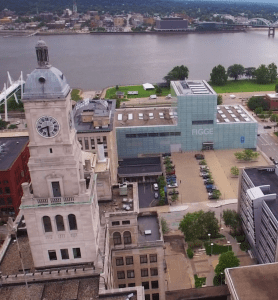
A bird’s-eye view of downtown Davenport, including the Figge Art Museum and the Mississippi River.
think that’s lost a lot. People think there’s nothing going on, or they don’t know that, and that’s very critical.”
Reinvigorating public art downtown also is a priority. The last major public art project DDP coordinated was the large “Welcome to Downtown Davenport” mural by Johnnie Cluney at the end of the Arsenal bridge in August 2017.
“We have lots of other partners around the region we want to get involved, but Quad City Arts will be involved,” Carter said of the new public art committee.
The new plan puts on hold a riverfront update done in February 2019, produced in in conjunction with RDG Dahlquist Art Studio (a division of RDG Planning & Design of Des Moines). That plan focused on the Davenport riverfront portion known as Main Street Landing from Harrison to Pershing.
“We’ll one day complete as much of RiverVision (including its RDG update) as possible, but those projects are mostly on hold until we get the results of the city’s Flood Resiliency Engineering Study by HR Green & Sasaki,” Carter said Thursday. “Once the city is provided those recommendations, we’ll see how RiverVision fits within the reconfigured riverfront puzzle.
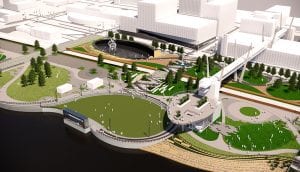
A 2019 riverfront plan by RDG Dahlquist Art Studio is on hold.
“As stated in the master plan, we expect to ultimately meet the challenge to balance both downtown’s flood protection needs and our century-long commitment to making the riverfront a vibrant destination,” he said. “It’s our understanding the first HR Green study results will be ready at the end of 2021.”
The goal of the 2019 RDG project was to integrate an artistic vision into the ongoing design and development of the RiverVision plan, ensuring greater opportunities for the public to engage and enjoy the Mississippi riverfront and downtown.
Further, the proposal seeks to develop an overall story for the riverfront that will establish it as an iconic destination and bolster its connection with downtown Davenport and the entire Q-C, the DDP said then.
Positive council reactions
Davenport Mayor Mike Matson said at Wednesday’s meeting how proud he was of how much downtown already has transformed and the ambitious goals in the new plan.
“We now have developed into the leading downtown in the region – an education center; a hospitality leader,” he said. “The amenities, the
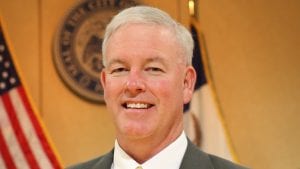
Mike Matson is mayor of Davenport.
forward thinking, the residential living community. I’ve been educated.”
“I have watched, I have listened and I have seen the tremendous effort and tremendous focus and work that the community, quite frankly,
has come together with the shining light of our downtown and how it’s developed,” Matson said. “When thousands of people now choose, that’s where I want to live. Thousands of people now choose to live there.
“And instead of people talking about, oh my God, what’s down there? Now they talk about, my God, let’s go down there, because of what is going on,” he said.
“It’s a good road map,” Ald. Raymond Ambrose of the master plan. “We’ve got a lot of them stacked in closets around city hall. We’ll give it a run. I know with Alisha’s assistance and leadership, I know it’s more likely to happen.”
Ald. Kyle Gripp thanked Carter for his inspiring words and the inspiring plan, as well as the public who took part.
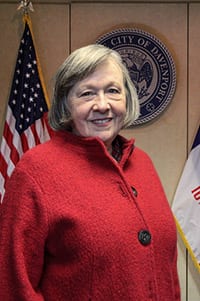
Marion Meginnis is the Davenport alderman who represents downtown.
“There is no obligation here because we have a process foe how we fund projects and programs,” he said. “It has to make the budget, have public discussion.”
“Accepting the plan gives the city a road map to where we all need to march collectively together,” Gripp said. “If we’re able to implement 40 percent of this, it would be an incredible accomplishment.
“It’s ludicrous to think this is an obligation,” he noted. “We have future city councils for that…We will have discussions about anything that comes forward, whether it’s in this plan or not.”
Ald. Matt Dohrmann said: “Downtown is really the head of our snake that really helps us drive this city. We need to continue to be great partners with them, because when downtown succeeds, all of Davenport succeeds.”
Ald. Marion Meginnis, who represents downtown and is a non-voting member of the DDP board, strongly supported the plan.
“I am astounded every single time at the work that goes on; the number of initiatives that this organization has and keeps in the fire. The things they continue to do despite Covid; they found ways to move forward,” she said. “Our downtown would be very much poorer without this group.”
“This council turns over every two years, A year from now there may be half the number of people sitting here,” Meginnis said, noting DDP will continue, offering long-term consistency.
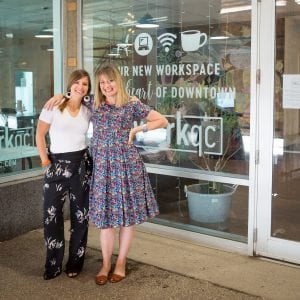
Amy Sivertsen, left, and Leslie Klipsch are co-owners of Coworkqc, 102 E. 2nd St., Davenport.
“When private investors are looking to come to downtown, they’re looking to people like the downtown partnership, put their investment in a way that’s intentional for the overall growth of the city,” agreed J.J. Condon, Alderman-At-Large.
“It’s going to be what makes the city sustainable – both our population and our economy,” he said of implementing the plan. “As big cities get bigger, it’s the ones that have the amenities and the culture and place-making that we design.”
For Davenport, this is just a starting point, but it’s an achievement in and of itself, Carter said Thursday. “That’s why we’re so celebratory – we feel like we’re starting off on a really great foot,” he said.
Helping downtown Rock Island
This has been a big week for the Q-C Chamber and downtowns, as the chamber also is contracting with the city of Rock Island to hire a new director for downtown Rock Island, which is doing similar planning to revitalize its city center.
That city council on Monday approved a $225,000 contract with the chamber to provide downtown place management services over two years.
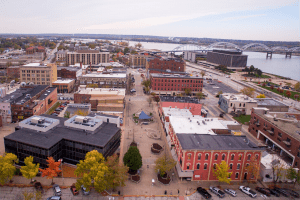
The Q-C Chamber will hire a new director to manage services for downtown Rock Island.
“The exciting thing about Rock Island is, it’s a blank canvas,” Carter said Thursday. “We are just getting started there and hiring a new director, but we still have to create the organization. The first thing we have to get done in downtown Rock Island is the agreement that we want an organization similar to what is in Bettendorf or Davenport, and the stakeholders there and folks who are ultimately going to pay the bill and give the feedback on what their vision is for their downtown – that they want that, they’re excited about that.
“We’ve got to build all those relationships,” he said of Rock Island. “There’s a lot of work to be done, laying the groundwork. Then you can get into the hard work of accomplishing all of those placemaking goals and place management goals – whether it be festivals or advocacy for certain kind of bills legislatively that would help downtown.”
“I think we have a great track record, and Ryan Jantzi in Bettendorf has done a spectacular job of that very thing – helping build trust and stakeholder input in downtown Bettendorf, and we hope to repeat that in downtown Rock Island,” Carter said.
The DDP and much newer Downtown Bettendorf Organization are both affiliates of the Q-C Chamber.
Information about the new downtown Rock Island director is on the chamber website, at http://bit.ly/RIdowntownsvcs, and the chamber is seeking qualified applicants. The director salary will be between $55,000 and $60,000, with plans to hire within six weeks.
For more information on the Davenport master plan, see the full master plan document or the executive summary.









